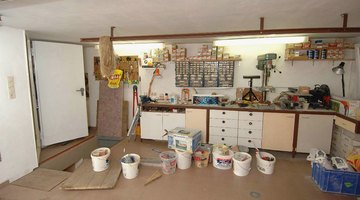How to Make Trapdoors That Look Hidden
You do not need to be Batman to have your own secret, underground lair. Trapdoors can provide a way to conceal storage space or another room that's simpler than a movable bookshelf or a wall with hinges. The beauty of such doors is that low-tech versions can be just as effective as their high-tech counterparts.

Before you start designing the hatch for your hidden door, make sure the adjoining room is structurally sound and properly ventilated.
-
Create a trapdoor that seamlessly blends with the surrounding flooring. This method works best if you have tile, a thick carpet or paneled flooring, like a laminate floor. When you lay down the flooring, instead of starting in the center of the room, start at the hatch. Ideally, the edges of the door will match the seams in the floor so the trapdoor is less obvious.
-
Put a trapdoor in the ceiling. Trapdoors often lead down into hidden rooms, but a hatch can just as easily lead up into an attic. To hide an attic trapdoor, construct a suspended or drop ceiling in the room or hallway using removable ceiling panels or large ceiling tiles. When you want to open the hatch, access it by simply removing the panel or tile that is covering the trapdoor.
-
Conceal the hatch under a rug if you find it difficult to seamlessly match your flooring to the visible side of the hatch. The best way to hide a trapdoor under a rug is to ensure the rug does not look out of place. For example, if the trapdoor is in the middle of a hallway, use a long rug that runs the length of the hall. If the trapdoor is in the corner of a room or along a wall, place furniture around the rug. For instance, you could place a reading chair and lamp at one end of the rug and an ottoman on top of the rug so it appears as if you purposefully staged a reading area.
-
Conceal the trapdoor under furniture. Another way to conceal a trapdoor that does not blend with the surrounding flooring is to place a large piece of furniture over the hatch, like a sofa. This method works best if you are going to access the hidden room on occasion; otherwise you might be moving heavy furniture more than you want.
-
Make a trapdoor inside a large piece of furniture. For example, if you build a secret room under a large kitchen, you can create a trapdoor in the middle of the floor, then conceal the hatch by building a large center island around the opening. One of the sides of the island should open like a cabinet door so you can access the trapdoor. While you may sacrifice storage space by hiding a trapdoor in a kitchen island, a stranger will never know the trapdoor under the furniture is there.
-
Make an outside trapdoor. When a secret room is aligned with an outer perimeter of a home, you can make a trapdoor that leads to the room from the outside. Make the trapdoor out of a weatherproof material, like stainless steel, and cover it with materials that match the surrounding landscaping, like dirt or bark dust. If it does not look out of place, you can place a potted plant over the hatch to further conceal it.
The Drip Cap
- You do not need to be Batman to have your own secret, underground lair.
- When you want to open the hatch, access it by simply removing the panel or tile that is covering the trapdoor.
- Another way to conceal a trapdoor that does not blend with the surrounding flooring is to place a large piece of furniture over the hatch, like a sofa.
- Make a trapdoor inside a large piece of furniture.
- For example, if you build a secret room under a large kitchen, you can create a trapdoor in the middle of the floor, then conceal the hatch by building a large center island around the opening.
- When a secret room is aligned with an outer perimeter of a home, you can make a trapdoor that leads to the room from the outside.
Writer Bio
Flora Richards-Gustafson has been writing professionally since 2003. She creates copy for websites, marketing materials and printed publications. Richards-Gustafson specializes in SEO and writing about small-business strategies, health and beauty, interior design, emergency preparedness and education. Richards-Gustafson received a Bachelor of Arts from George Fox University in 2003 and was recognized by Cambridge's "Who's Who" in 2009 as a leading woman entrepreneur.
Photo Credits
- Getty Images/Getty Images News/Getty Images
- Getty Images/Getty Images News/Getty Images
More Articles



